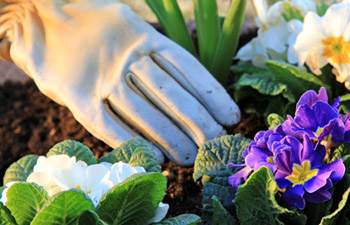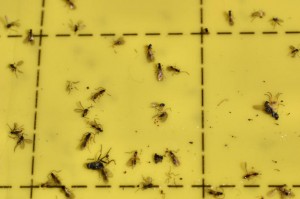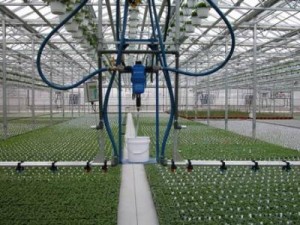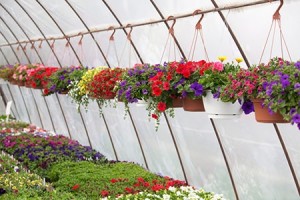Read More in The Sun Gro’er Issue 2/1 (2004)
With spring just around the corner and the recent introduction of the Sunshine Ellepot Propagation System, it seems like a good time to review the basic cultural requirements for successful vegetative propagation. The use of unrooted cuttings to produce annuals and herbaceous perennials is on the increase, partly because desirable species and cultivars from offshore production facilities can be delivered faster and for lower cost than ever before. And while the phrase ‘offshore production’ may touch off heated debate among protectionists and free-trade advocates, in this case cuttings that originate in the Southern Hemisphere while we shiver up here up North may actually
have a quality advantage. And that leads us to our first consideration, what constitutes quality in an unrooted cutting?
Continue reading “Vegetative Propagation Basics”
Author: Jan Perez
Root Zone Disease Management—Go Biological or Not?
Read More in The Sun Gro’er Issue 1/2 (2003)
In recent months there has been a lot of hype in industry journals and trade shows about biological fungicides (BFs). The intention of this article is to provide some background information on these types of products and also to provide some guidance in determining if biological fungicides are right for you or your customers.
A biological fungicide (BF) is a living organism that is used to suppress or control a plant disease typically caused by a pathogenic (disease-causing) fungus. Biological fungicides utilize microorganisms from one of two groups – fungi or bacteria. The most common root diseases found in greenhouse production are Pythium, Phytophthora, Rhizoctonia, Thielaviopsis, and Fusarium.
Continue reading “Root Zone Disease Management—Go Biological or Not?”
Media, Tissue and Water Testing for Good Growing
 Read More in The Sun Gro’er Issue 1/2 (2003)
Read More in The Sun Gro’er Issue 1/2 (2003)
When do most growers test media, tissue or water in the greenhouse? If your answer is “only when there is a problem”, you are probably right. However, that is not the only time that growers should be testing. Growers should be testing at least for media pH and EC on a weekly or bi-monthly basis (on-site testing) and should also be conducting complete tests 2 or more times per crop for major crops (complete lab analysis).
Tests should not be limited to media pH and EC, but also to water alkalinity, EC and pH. This is especially important if growers are having problems maintaining pH in their mixes. Knowing the alkalinity of the water and fertilizing according to the alkalinity goes a long way in helping assure a successful, high quality crop. This is a separate topic in and of itself.
Continue reading “Media, Tissue and Water Testing for Good Growing”
Controlling Greenhouse UFP’s (Unidentified Flying Pests)

Almost all greenhouse growers find themselves battling little black flying insects in their greenhouses at some point in their careers. Small black flying gnats can be shore flies (Ephydridae family) or fungus gnats (Sciaridae or Mycetophilidae families).
The shore flies are commonly found in greenhouses or nurseries where algae is growing on the soil surface or floor. They feed on algae and although they are a nuisance, they pose no threat to plants. Their larvae look like maggots and are wedge shaped. The adults look more like the common housefly flies with short bodies and small antennae. Continue reading “Controlling Greenhouse UFP’s (Unidentified Flying Pests)”
Calibrating Fertilizer Injectors
 Read More in The Sun Gro’er Issue 1/1 (2003)
Read More in The Sun Gro’er Issue 1/1 (2003)
So you’ve just used that brand new conductivity meter to measure the EC of your customer’s fertigation solution, and it doesn’t match the value that corresponds to the ppm N that the grower thinks they’ve been applying forever. What to do now? Since you’re already sure that the EC meter is properly calibrated, you better check that fertilizer injector! Fortunately, it’s not that hard to do.
Sun Gro's Technical Specialists
Read More in The Sun Gro’er Issue 1/1 (2003)
Sun Gro has seven main Technical Specialists, three in the West and two each in the Central and East regions. Their duties include Quality Control (QC) work with specific plants, along with providing technical support for specific sections of their region. Technical support includes work with complaint handling, training and custom blends. These are also the Sun Gro staffers who will be providing most of the content for the Sun Gro’er Newsletter. Here is some basic information that will allow readers to get to know them a little better: Continue reading “Sun Gro's Technical Specialists”
Notes from North Central
 Read More in The Sun Gro’er Issue 1/1 (2003)
Read More in The Sun Gro’er Issue 1/1 (2003)
“For growers who desire low EC levels and do not want to leach the ideal solution is the use of growing media products with reduced nutrient charges.”
The measurement of soluble salts tests the “fitness” of growing media in the greenhouse. The amount of soluble salts is assessed by measuring the electrical conductivity (EC) of a mix. Watering practices have a dramatic effect on the levels of soluble salts in a growing medium. Salts originating from fertilizers or water provided to a crop can and will “build up” as leaching is reduced or eliminated. So a critical point to remember is that when growers reduce leaching for various reasons, especially with larger sized containers like hanging baskets, growers will most likely see higher EC levels. Invariably nothing has changed in the mix but the growing practice. Continue reading “Notes from North Central”
Sulfur – an emerging star
By Shiv K. Reddy and Paul A. King
Don’t ignore sulfur’s role in your plant nutrition program. Sulfur helps plants form chlorophyll that leads to greener foliage and sulfur is very important in floriculture where consumers are concerned about plants’ appearances.
Plants require significant amounts of sulfur – as much as phosphorus – for optimum growth. In fact, healthy plant tissues contain similar sulfur and phosphorus concentrations.
Read Sulfur – an emerging star
